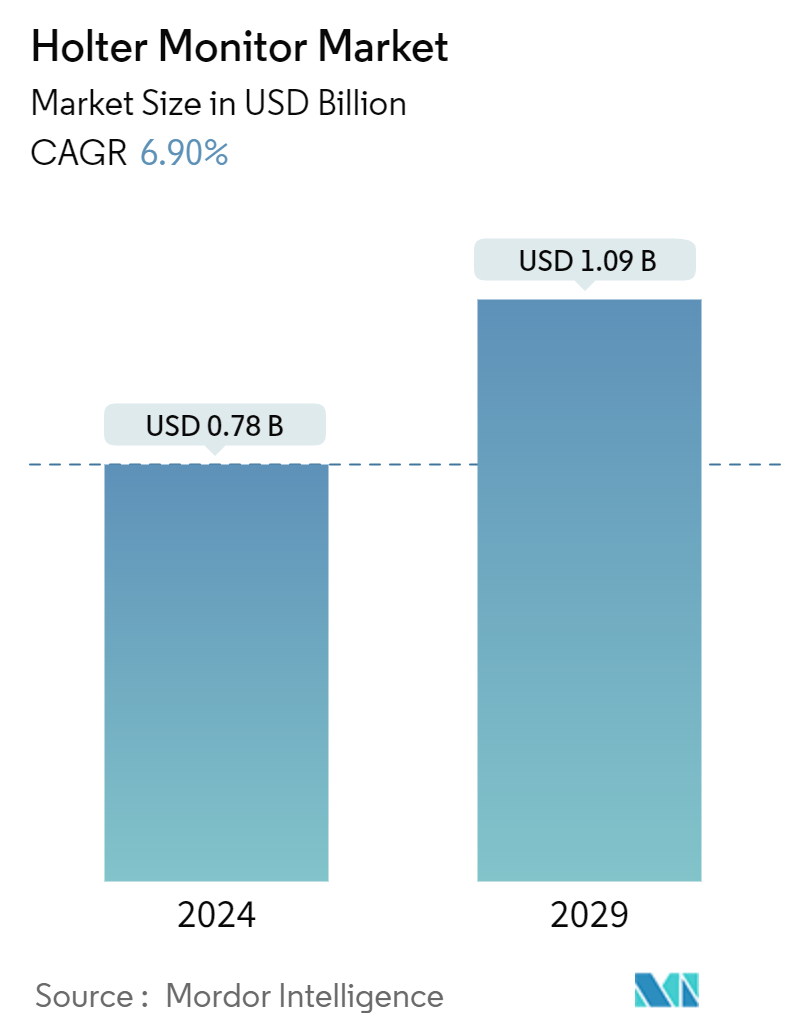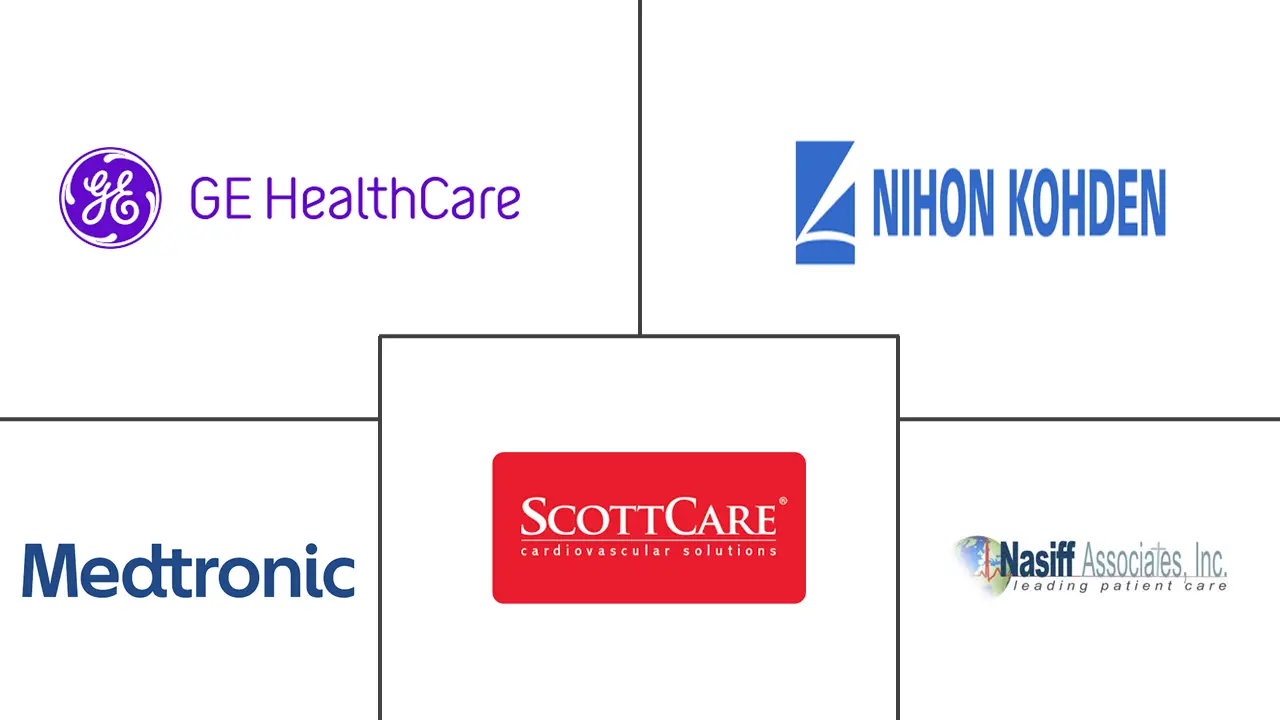Market Size of Holter Monitor Industry

| Study Period | 2021 - 2029 |
| Market Size (2024) | USD 0.78 Billion |
| Market Size (2029) | USD 1.09 Billion |
| CAGR (2024 - 2029) | 6.90 % |
| Fastest Growing Market | Asia Pacific |
| Largest Market | North America |
| Market Concentration | Medium |
Major Players
*Disclaimer: Major Players sorted in no particular order |
Holter Monitor Market Analysis
The Holter Monitor Market size is estimated at USD 0.78 billion in 2024, and is expected to reach USD 1.09 billion by 2029, growing at a CAGR of 6.90% during the forecast period (2024-2029).
Atrial fibrillation is the most clinically significant in humans when it is viewed at global levels. It is a serious health problem because of its increasing incidence and prevalence in the geriatric population. The early diagnosis of atrial fibrillation is important since arrhythmias significantly increase the risk of heart failure, stroke, and tachycardia-induced cardiomyopathy with reduced cardiac function. The prevalence of atrial fibrillation is often miscalculated due to the high frequency of clinically silent atrial fibrillation as well as paroxysmal atrial fibrillation, both of which are hard to detect by routine physical examination or 12-lead electrocardiogram. The development of wearable devices has provided a steadfast way for healthcare providers to uncover undiagnosed atrial fibrillation in people, especially those most at risk. Artificial intelligence and wearable technology have made it possible to extract and analyze many aspects to identify and predict patient groups that traditional detection methods were unable to identify due to the exponential growth of digital clinical data.
Moreover, various advantages associated with these devices contribute to the market growth and are essential in diagnosing and assessing various heart conditions, such as arrhythmias and myocardial infarction. For instance, in August 2022, SmartCardia launched the 7L patch, its 7-lead cardiac monitoring patch, in India. This state-of-the-art patch monitor combines medical wearable technology with artificial intelligence (AI) to provide predictive and personalized patient insights through remote monitoring. Also, in March 2022, Biotricity, a US-based biotechnology company, launched a wireless, wearable cardiac monitoring device for the early detection of cardiac arrhythmias.
Furthermore, strategic efforts by prominent market competitors are positively influencing market growth. For instance, in August 2023, Philips, at the European Society of Cardiology, showcased how specific diagnostic referral codes can potentially help Holter monitoring to monitor symptoms remotely, which prevents further hospitalization. Philips has created extended ECG Holter monitoring, which can improve diagnostic outcomes. Hence, such initiatives are likely to increase the product awareness and reach, thereby contributing to the market growth.
However, the strict and complex reimbursement policies and documentation challenges are the factors that hinder the growth of the Holter monitor market.
Holter Monitor Industry Segmentation
A Holter monitor is a small, wearable device that records the heart's rhythm. It detects and determines the risk of irregular heartbeats (arrhythmias).
The Holter monitor market is segmented by product, lead type, end user, and geography. Based on product type, the market is segmented into wired and wireless types. Based on lead type, the market is segmented as patch type lead Holter monitor, 3-lead monitor, 6-lead monitor, 12-lead monitor, and other lead types. Based on end-users, the market is segmented into hospitals, cardiac centers, ambulatory surgical centers, and other end-users. Based on geography, the market is segmented as North America, Europe, Asia-Pacific, Middle East and Africa, and South America. The market report covers the estimated market sizes and trends for 17 countries across major regions globally. The report offers market size and forecast in terms of value (USD) for the above segments.
| By Product Type | |
| Wired Holter Monitors | |
| Wireless Holter Monitors | |
| Software System |
| By Lead Type | |
| Patch Type Lead Holter Monitor | |
| 3- Lead Monitor | |
| 6- Lead Monitor | |
| 12- Lead Monitor | |
| Other Lead Type |
| By End User | |
| Hospitals | |
| Ambulatory Surgical Centres | |
| Other End Users |
| Geography | ||||||||
| ||||||||
| ||||||||
| ||||||||
| ||||||||
|
Holter Monitor Market Size Summary
The Holter monitor market is poised for significant growth, driven by the increasing prevalence of atrial fibrillation and other cardiovascular conditions, particularly among the geriatric population. The development of wearable devices and advancements in artificial intelligence have revolutionized the detection and monitoring of these conditions, enabling healthcare providers to identify undiagnosed cases that traditional methods often miss. These portable and non-invasive devices offer numerous advantages, such as ease of use and the ability to provide real-time data, which are crucial for diagnosing and assessing heart conditions like arrhythmias and myocardial infarction. The integration of big data and AI further enhances their capabilities, making them an essential tool in modern healthcare.
The market is also benefiting from strategic initiatives by key players, such as product launches and collaborations, which are increasing awareness and adoption of Holter monitors. Despite challenges like complex reimbursement policies, the market is expected to expand due to the growing demand for remote monitoring solutions and the rise of telemedicine. The introduction of innovative and miniaturized devices, such as the Zio patch and CardioSTAT, underscores the ongoing technological advancements in this field. The competitive landscape is characterized by a mix of international and regional companies, with major players like GE Healthcare, Nihon Kohden, and Medtronic leading the market.
Holter Monitor Market Size - Table of Contents
-
1. MARKET DYNAMICS
-
1.1 Market Overview
-
1.2 Market Drivers
-
1.2.1 Increased Geriatric Population and Prevalence of Atrial Fibrillation
-
1.2.2 Rising Incidence of Cardiovascular Diseases
-
1.2.3 Increasing Demand for Early Detection and Treatment Diagnostic Tools
-
-
1.3 Market Restraints
-
1.3.1 The Stringent Approvals and Healthcare Reimbursement Policies
-
-
1.4 Porter's Five Forces Analysis
-
1.4.1 Threat of New Entrants
-
1.4.2 Bargaining Power of Buyers/Consumers
-
1.4.3 Bargaining Power of Suppliers
-
1.4.4 Threat of Substitute Products
-
1.4.5 Intensity of Competitive Rivalry
-
-
-
2. MARKET SEGMENTATION (Market Size by Value - USD)
-
2.1 By Product Type
-
2.1.1 Wired Holter Monitors
-
2.1.2 Wireless Holter Monitors
-
2.1.3 Software System
-
-
2.2 By Lead Type
-
2.2.1 Patch Type Lead Holter Monitor
-
2.2.2 3- Lead Monitor
-
2.2.3 6- Lead Monitor
-
2.2.4 12- Lead Monitor
-
2.2.5 Other Lead Type
-
-
2.3 By End User
-
2.3.1 Hospitals
-
2.3.2 Ambulatory Surgical Centres
-
2.3.3 Other End Users
-
-
2.4 Geography
-
2.4.1 North America
-
2.4.1.1 United States
-
2.4.1.2 Canada
-
2.4.1.3 Mexico
-
-
2.4.2 Europe
-
2.4.2.1 Germany
-
2.4.2.2 United Kingdom
-
2.4.2.3 France
-
2.4.2.4 Italy
-
2.4.2.5 Spain
-
2.4.2.6 Rest of Europe
-
-
2.4.3 Asia-Pacific
-
2.4.3.1 China
-
2.4.3.2 Japan
-
2.4.3.3 India
-
2.4.3.4 Australia
-
2.4.3.5 South Korea
-
2.4.3.6 Rest of Asia-Pacific
-
-
2.4.4 Middle East and Africa
-
2.4.4.1 GCC
-
2.4.4.2 South Africa
-
2.4.4.3 Rest of Middle East and Africa
-
-
2.4.5 South America
-
2.4.5.1 Brazil
-
2.4.5.2 Argentina
-
2.4.5.3 Rest of South America
-
-
-
Holter Monitor Market Size FAQs
How big is the Holter Monitor Market?
The Holter Monitor Market size is expected to reach USD 0.83 billion in 2025 and grow at a CAGR of 6.90% to reach USD 1.16 billion by 2030.
What is the current Holter Monitor Market size?
In 2025, the Holter Monitor Market size is expected to reach USD 0.83 billion.

